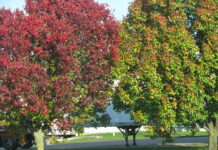Photo credit: DiasporaEngager (www.DiasporaEngager.com).
What about water filters?
Most home water filters are not designed to remove germs from your water. They typically use a carbon filter to remove impurities like lead or to improve the taste of your water. Germs that live in biofilms can grow and multiply in these devices when they are not properly maintained and replaced according to the manufacturer’s instructions.
Common types of water filters include:
- Pitcher and countertop filters
- Refrigerator and icemaker filters
- Under sink filters
- Showerhead and faucet filters
You can also get whole-home water filters, which are installed at the point where water enters your home. That way, all the water coming out of every tap and showerhead is filtered. Some whole-home water filters remove water treatment chemicals, such as chlorine. If you decide you want a water filter, knowing what you want your water filter to do is an important first step to choosing the right one.
People with weakened immune systems should talk to their healthcare provider and a water disinfection specialist about whether they should consider installing a specialized whole-home water filter.
Get more information:
Portable Humidifiers
Germs can live in humidifiers unless you empty all water from them daily, clean them properly on a regular basis, and allow them to air dry after cleaning. These germs can spread through the mist the humidifier creates when you turn it on.
Follow the manufacturer’s instructions for cleaning and drying your humidifier to prevent germs from growing and spreading. Consider using distilled or boiled (and then cooled) water or water disinfected with chlorine bleach in portable humidifiers.
Neti Pots/Nasal Rinses
Always follow the manufacturer’s instructions when using and cleaning devices to clear or flush sinuses, like neti pots or nasal rinses. Never use water straight from the tap to rinse your sinuses. Instead, use distilled water or tap water that you have boiled (and then cooled) to rinse sinuses. If distilled or boiled water is not available, disinfect tap water or filter it before you use it. If using filtered water, it is essential to use a filter with a label that reads “NSF 53” or “NSF 58,” or contains the words “cyst removal” or “cyst reduction.”
Showerheads and Faucet Aerators
Clean showerheads and faucet aerators whenever you can see buildup to help prevent germs from growing within the faucet. The aerator is the mesh screen screwed into your faucet that helps with water flow. You may need to remove the showerhead and hose and soak them in a solution (such as white vinegar) to remove buildup. Follow the manufacturer’s instructions for cleaning.
Water Heaters
Set the Water Heater Temperature
Keeping your home’s water heater temperature set at an appropriate level can help reduce the growth of some germs (such as Legionella). A water temperature of 130–140°F can kill many harmful germs, but also increases the risk of scalding. If you set the water heater above 120°F, take extra precautions to mix cold and hot water (using thermostatic valves) at the faucet or shower to avoid scalding. This is especially important if young children, older adults, or other people at increased risk of scalding live in your home. Ask your healthcare professional about your risk of Legionella infection to decide on the best course of action.
Flush the Water Heater
Regularly flushing your water heater can prevent germs from growing, make it last longer, and is recommended by most manufacturers. If you decide to flush your water heater, follow the manufacturer’s instructions or have a professional do the work. Many manufacturers recommend flushing your water heater:
- Annually
- Before you move into a home
- After plumbing work
- If the water is discolored
Communicate with your water utility
Sometimes events disrupt the flow of water into your home. These can be planned (for example, your water utility makes repairs to the water system) or unplanned (for example, a water main breaks). Germs may be able to enter the pipes in your home during these disruptions. You can take steps to stay informed and ensure the water in your home is safe to use:
- Sign up to receive messages and advisories (e.g., boil water advisories) about your water. This may require opting in with your utility or local government alert system.
- Follow all recommendations related to water use during the advisory.
- Contact your water utility if you notice a decrease in water pressure throughout your home or see brown or discolored water.
- After a loss in water pressure, flush water through each faucet and shower in your home until it starts to get hot and runs clear (with no discoloration). Contact your water utility for more recommendations.
Keep private water sources safe
In homes that use private wells or other private water sources, the homeowner is responsible for the safety of the water. Guidance and recommendations to keep well water safe are available from CDC.
Check with your building manager, owner, or landlord
If you live in an apartment building or other building with multiple housing units, you can talk to your building’s owner, manager, or landlord about what steps they are taking to protect residents from waterborne germs.
Source of original article: Centers for Disease Control and Prevention (CDC) / CDC Features Series (tools.cdc.gov).
The content of this article does not necessarily reflect the views or opinion of Global Diaspora News (www.GlobalDiasporaNews.com).
To submit your press release: (https://www.GlobalDiasporaNews.com/pr).
To advertise on Global Diaspora News: (www.GlobalDiasporaNews.com/ads).
Sign up to Global Diaspora News newsletter (https://www.GlobalDiasporaNews.com/newsletter/) to start receiving updates and opportunities directly in your email inbox for free.

































